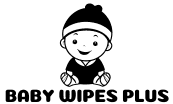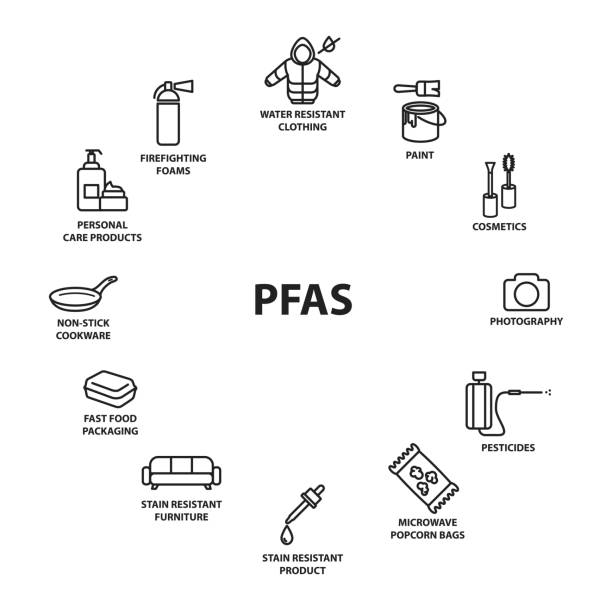PFAS in Baby Wipes Now Found in Everyday Baby Products?
After PFAS in baby wipes today, I will tell you about other baby products that contain PFAS chemicals; you’ll see how much PFAS is involved in each product. Is using that product harmful or not? How do we identify and what are the alternative solutions to escape from PFAS chemicals. PFAS means (Per- and Polyfluoroalkyl Substances) usually called “forever chemicals.” Because they do not break down naturally. Widely used in various industries for their water- and stain-resistant properties, PFAS have raised alarms due to their persistence in the environment and potential health risks.
These chemicals can cause significant diseases in children, like hormone disruption, immune system issues, and even certain cancers. Babies and young children are mainly hunted. Because their bodies are still developing, they are more likely to come into close contact with these products.
While much attention has been focused on PFAS in baby wipes, these chemicals also exist in many other baby products. This article dives deep into the surprising sources of PFAS in items like baby clothes, diapers, and car seats, evaluates their safety, and provides actionable advice for parents looking to make safer choices.
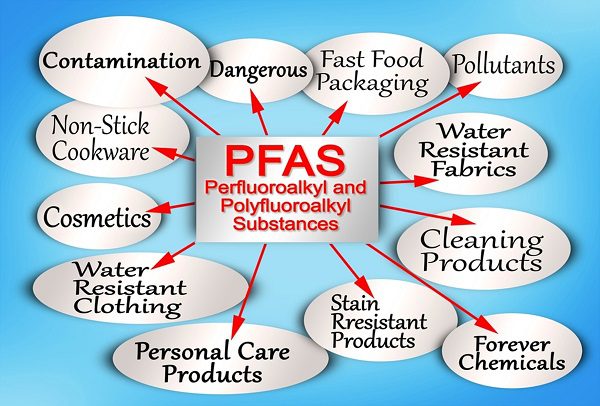
What Are PFAS in Baby Wipes, and Why Are They Harmful?
PFAS are a group of synthetic chemicals used to make products water-resistant, stain-proof, and non-stick. Famous examples include PFOA and PFOS, which are often found in everyday items like cookware, textiles, and food packaging. These chemicals are known for their durability, but this same property makes them harmful. Once introduced into the environment or human body, PFAS persist for years, accumulating over time.
According to research, PFAS exposure to various health issues, including:
- Developmental delays in infants and children.
- Hormonal imbalances and reproductive issues.
- Immune system suppression increases susceptibility to infections.
- Higher risks of certain cancers, such as kidney and testicular cancer.
Babies are particularly at risk due to their smaller size, thinner skin, and higher exposure levels relative to their body weight. Whether through direct skin contact, inhalation, or ingestion, babies can unknowingly absorb PFAS from products designed to protect and comfort them.
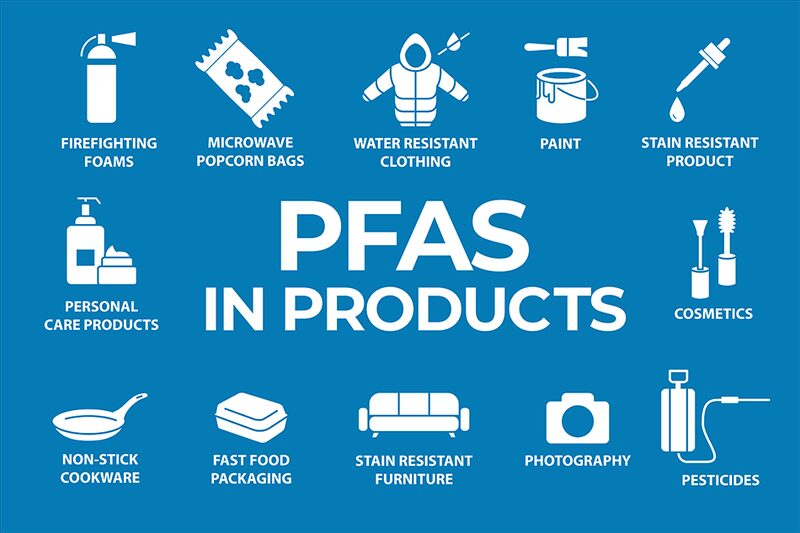
PFAS in Baby Products Which Products Contained More?
1. Baby Clothing and Sleepwear
This products include PFAS and are commonly used to make water and stain-resistant baby clothes, ensuring they remain durable through spills and washes.
Statistics: Over 50% of water-resistant baby clothing tested worldwide contains PFAS.
Risks: Prolonged skin contact can lead to irritation or low-level chemical absorption, which may accumulate in the body over time.
Alternatives: Choose untreated organic cotton or bamboo fabrics certified by GOTS (Global Organic Textile Standard).
2. Diapers and Disposable Underwear
Disposable underwear and baby diapers include “Forever chemicals” to improve the leakage barriers and moisture-wicking capabilities of baby diapers, making them more effective at keeping babies dry.
Statistics: Approximately 30% of tested diapers show detectable levels of PFAS.
Risks: These chemicals can leach into the baby’s skin during prolonged contact, raising potential health concerns.
Alternatives: Cloth diapers, use biodegradable wipes or diapers, or use PFAS-free disposable diapers from trusted brands.
3. Crib Mattresses and Waterproof Covers
To protect against spills and leaks, crib mattresses and covers contain PFAS for stain resistance and durability. Don’t worry. PFAS is applied on the outer side of mattresses and covers
Statistics: Over 60% of crib mattresses with waterproofing features contain PFAS.
Risks: Off-gassing volatile chemicals may lead to inhalation exposure, particularly concerning during sleep.
Alternatives: Natural latex mattresses with organic cotton or untreated wool covers.
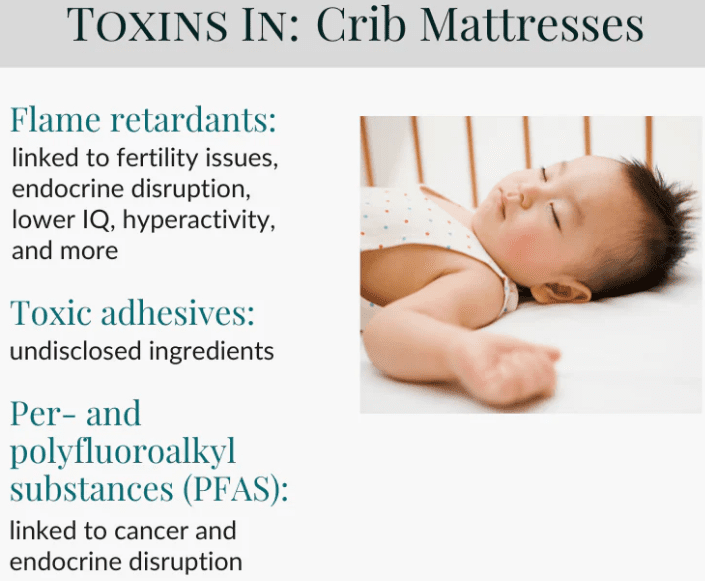
4. Car Seats and Strollers
Car seats and strollers are often coated with PFAS to enhance their stain resistance and meet flame retardancy standards. PFAS ensures the fabric remains durable and clean, even with frequent use.
Statistics: Around 70% of car seats tested contained PFAS, posing risks from frequent handling and close proximity to the baby.
Risks: Long use can lead to direct exposure via skin contact or inhalation of chemical remains.
Alternatives: Seek products certified by OEKO-TEX or GreenGuard Gold, which ensure low chemical emissions.
5. Baby Food Packaging
Many baby food pouches, wrappers, and containers are lined with PFAS to make them grease-resistant and prevent leaks.
Statistics: Researchers found that around 40% of baby food packaging materials tested contained PFAS. The chemicals can leach into the food, particularly when exposed to heat or over time.
Risks: Ingested PFAS chemicals may directly impact developing organs and lead to long-term health issues in babies.
Alternatives: Opt for glass jars or certified PFAS-free packaging.
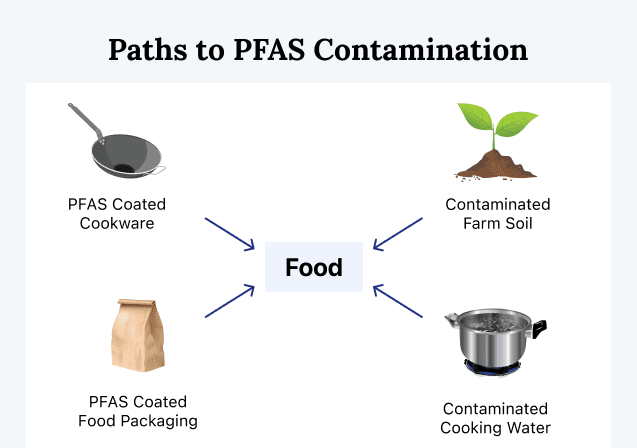
6. Toys and Play Mats
Non-stick or stain-resistant coatings on play mats and toys slightly contain PFAS. These treatments are applied to create easy-to-clean surfaces, particularly for products marketed as “waterproof” or “spill-proof.”
Statistics: Many “waterproof” labeled mats are coated with PFAS.
Risks: Babies often chew, touch, and inhale particles from these items, increasing exposure.
Alternatives: Select toys made from untreated wood or natural rubber, and choose foam mats without chemical treatments. Certifications like BPA-free or phthalate-free labels may also indicate the absence of PFAS.
7. Breast Pump and Bottle Accessories
Some breast pump tubing and bottle accessories use PFAS coatings to improve flexibility, durability, and resistance to leakage.
Statistics: While comprehensive data is limited, emerging studies suggest PFAS may be present in pump parts that frequently come into contact with expressed milk.
Risks: Even trace amounts of PFAS in these accessories can transfer to breast milk, introducing the chemicals directly into a baby’s diet.
Alternatives: Use BPA- and PFAS-free certified silicone products.
How to Identify PFAS in Baby Products
- Why PFAS Aren’t Labeled: Many manufacturers rarely disclose the use of PFAS in baby products directly, companies claim trade secrets, and vague terms like “waterproof” or “stain-resistant” obscure their use.
- Step-by-Step Guide:
- Look for certifications like OEKO-TEX, GOTS, or GreenGuard Gold.
- Avoid red-flag terms like “waterproof,”, “stain-resistant,” or ” non-stick.”
- Contact brands for precise information about chemical treatments.
- Certifications to Trust: GOTS-certified fabrics, OEKO-TEX-tested materials, and GreenGuard Gold labels ensure low or no chemical emissions.
Conclusion
PFAS in baby products pose severe risks to health and the environment, making their presence in baby products a growing concern. These PFAS or hidden chemicals can unknowingly expose babies to harmful effects, from clothing and diapers to toys and food packaging. However, with knowledge and proactive steps, parents can protect their children by choosing safer, PFAS-free alternatives.
By prioritizing certified products and demanding greater brand transparency, we can create a safer, healthier future for our children one informed choice at a time. Let’s advocate for stricter regulations and make PFAS-free products the norm, not the exception.
